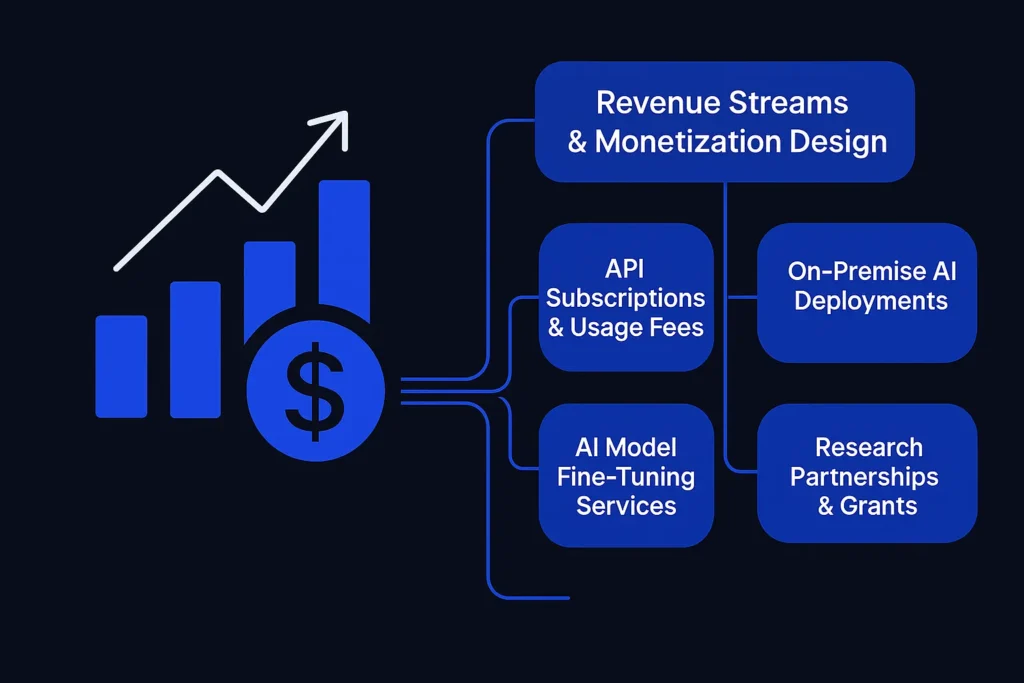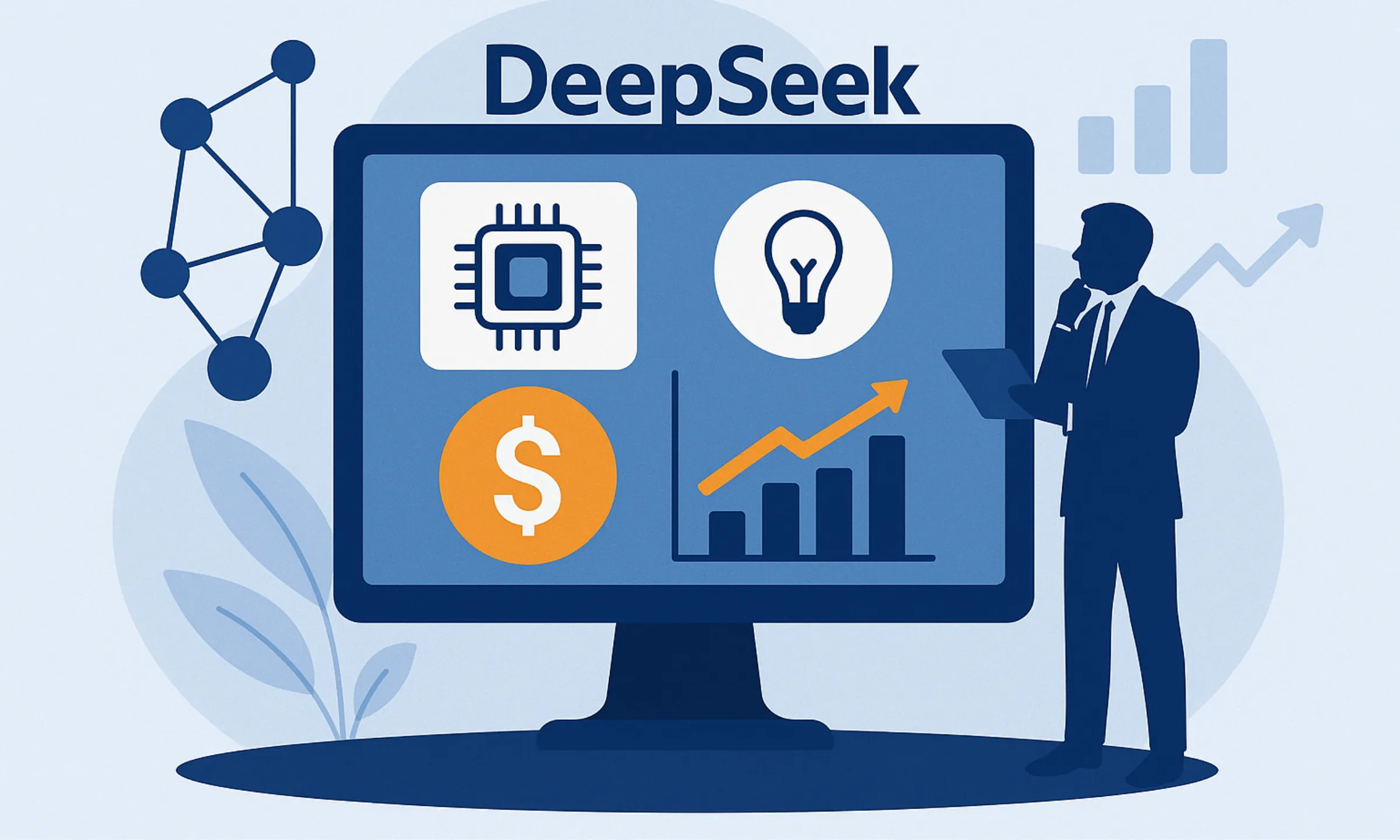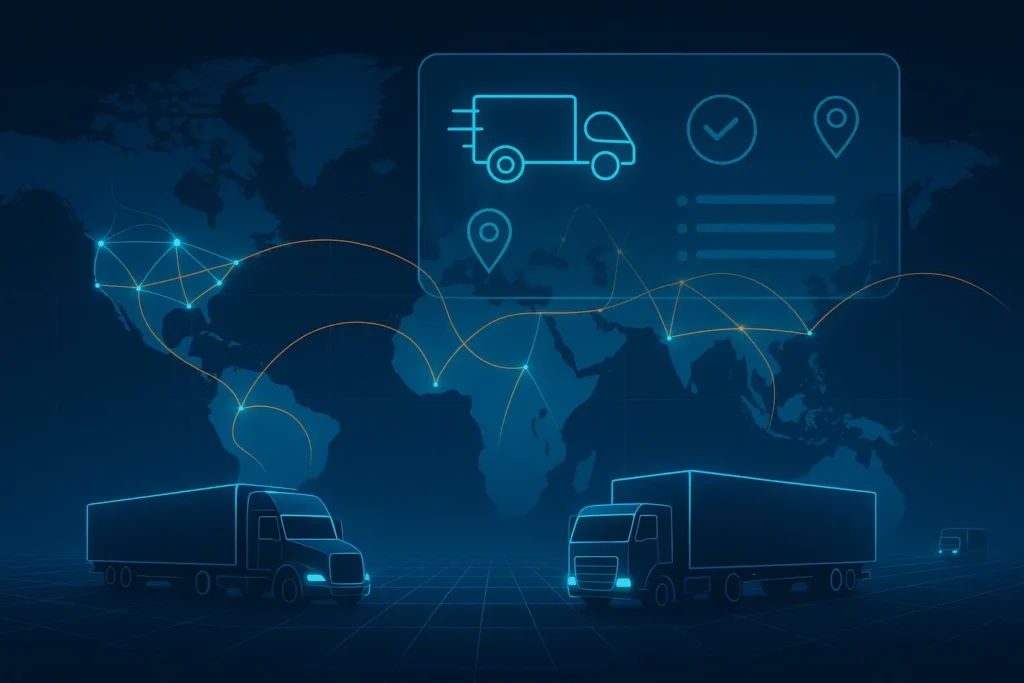In just three years, DeepSeek transitioned from an experimental LLM project to a strategic national asset — blending academic-grade R&D with aggressive enterprise deployment. As of 2025, it has become the benchmark for cost-efficient AI model training and inference, driving adoption across Asia, the Middle East, and emerging markets where Western AI pricing has been prohibitive.
The Business Model of DeepSeek stands as a masterclass in AI democratization, sovereign technology independence, and scalable monetization. Understanding how DeepSeek monetizes its models, structures partnerships, and builds sustainable growth mechanisms offers invaluable lessons for entrepreneurs building the next wave of AI-driven platforms.
How the DeepSeek Business Model Works
DeepSeek operates on a hybrid AI-as-a-Service (AIaaS) model — a blend of open-access language models, enterprise-grade API monetization, and sovereign customization solutions. It merges the scalability of Western
AI platforms with the cost-efficiency and national adaptability that emerging markets demand.
Core Framework Overview
At its core, DeepSeek’s business model is built on four synchronized layers of value creation:
- Model Layer (Foundation AI Models):
- DeepSeek develops large-scale transformer-based LLMs (e.g., DeepSeek-Coder, DeepSeek-Math, DeepSeek-V2) optimized for multilingual, technical, and contextual reasoning.
- These models are trained using proprietary mixed datasets—partly public, partly nationalized data—to ensure accuracy across multiple languages and regions.
- API & Platform Layer (AIaaS Monetization):
- Enterprises, governments, and startups subscribe to DeepSeek’s API services for NLP, vision, and reasoning capabilities.
- Offers pay-per-use, subscription, and on-premise deployment models.
- APIs are cheaper by 60–80% compared to OpenAI or Anthropic, making them ideal for high-volume usage in developing economies.
- Customization Layer (Sovereign & Enterprise Solutions):
- DeepSeek licenses fine-tuned versions of its models to government bodies, universities, and corporate clients.
- These deployments are tailored to national data laws and vertical applications (education, finance, manufacturing, healthcare).
- This layer generates long-term recurring contracts and partnerships.
- Research & Ecosystem Layer (Community + Open Innovation):
- DeepSeek maintains an open-research initiative similar to Hugging Face or Stability AI, encouraging academic and developer collaboration.
- This builds community goodwill while creating a talent pipeline for R&D scaling.
Key Insights
| Factor | Description |
| Type of Model | Hybrid: AIaaS + B2B Licensing + Open Innovation |
| Primary Value Proposition | Enterprise-grade AI access at 1/10th cost; national customization; multilingual performance |
| Stakeholders | Developers, enterprise clients, government agencies, academic partners |
| Evolution | Started as open LLM in 2023 → full-stack AI ecosystem by 2025 |
| Why It Works (2025) | Global cost pressures + AI sovereignty demand + edge computing growth |
Read more : What is DeepSeek and How Does It Work?
Target Market & Customer Segmentation Strategy
DeepSeek’s growth has been driven by identifying underserved segments in the global AI landscape — entities that demand high intelligence at low operational costs. Unlike Western LLM providers focused on premium enterprise clients, DeepSeek strategically positioned itself as the AI backbone for cost-sensitive economies and state-driven digital ecosystems.
Primary Customer Segments
- Enterprise AI Adopters (B2B Core):
- Mid-to-large enterprises integrating chatbots, automation, analytics, and coding tools.
- Sectors: Finance, logistics, manufacturing, healthcare, and education.
- Motivation: Replace expensive API dependencies with high-performance, localized models.
- Government & Public Sector Clients:
- Ministries and national R&D bodies in China, UAE, India, and Southeast Asia.
- Use Cases: Translation systems, document summarization, citizen portals, defense simulations.
- Key Need: Data privacy, sovereignty compliance, and on-premise deployment.
- Developers & AI Startups:
- Independent builders who need affordable, open-access LLM APIs.
- Access via DeepSeek’s developer platform, with tiered free and premium options.
- They drive ecosystem virality through community projects and GitHub integrations.
- Educational Institutions & Research Labs:
- Universities and think tanks using DeepSeek’s open models for language research and AI experiments.
- Builds brand reputation and academic credibility while fueling future workforce alignment.
Secondary Segments
- AI Tool Integrators: Software firms embedding DeepSeek’s APIs into CRMs, ERPs, and chat assistants.
- Global Developers from Emerging Economies: Especially across Africa, Latin America, and South Asia — leveraging localized model performance.
Customer Journey & Retention Funnel
| Stage | Description | DeepSeek Mechanism |
| Discovery | Users encounter DeepSeek through research reports, developer forums, and tech media. | Thought-leadership marketing + open benchmarks |
| Evaluation | Compare model accuracy, latency, and cost vs. OpenAI, Claude, Gemini. | Transparent test dashboards & multilingual benchmarks |
| Adoption | Enterprises deploy APIs or fine-tuned on-prem models. | Quick integration SDKs, low latency, pay-as-you-scale |
| Retention | Continuous model updates, custom datasets, AI consulting. | Loyalty pricing, SLA guarantees, and local partnerships |
Market Positioning
- Competitive Edge:
DeepSeek’s brand is defined by “intelligence without borders.” It champions accessibility, open infrastructure, and sovereign innovation. - Market Share (2025 Estimate):
- 12–15% of the enterprise LLM API market in Asia-Pacific.
- Fastest-growing AI provider in Middle East and Africa segments.
Global recognition as the most cost-effective per-token AI engine in 2025.
Revenue Streams and Monetization Design
DeepSeek’s monetization framework combines AI-as-a-Service (AIaaS) scalability with long-term enterprise licensing — ensuring both recurring revenue and infrastructure cost recovery. Unlike pure API platforms, DeepSeek diversified early to avoid dependency on a single revenue line, creating a multi-layered monetization ecosystem.
1. Primary Revenue Stream – API Subscriptions & Usage Fees (~45–50%)
Mechanism:
DeepSeek provides scalable API access to its models (e.g., DeepSeek-V2, DeepSeek-Math, DeepSeek-Coder) via tiered pricing:
- Free tier: Limited tokens for developers, driving initial adoption.
- Pro tier: Pay-per-token access for startups and SMBs.
- Enterprise tier: Custom usage limits with advanced model access and SLA guarantees.
Pricing Model (2025):
- $0.0004–$0.001 per 1K tokens (≈70% cheaper than OpenAI).
- Tiered enterprise contracts averaging $10K–$50K/month, depending on compute load.
Growth Trajectory:
As of Q3 2025, API revenue grew 240% year-over-year, powered by partnerships in India, MENA, and Europe.
2. Secondary Revenue Stream – On-Premise AI Deployments (~25%)
Mechanism:
DeepSeek licenses customized AI models for on-premise or private cloud installations — vital for government, defense, and banking clients prioritizing data control.
Key Features:
- Annual licensing + model retraining packages
- Local language adaptation and domain tuning
- Infrastructure integration (with Huawei, Alibaba Cloud, and NVIDIA partners)
Revenue Impact:
High upfront setup fees ($250K–$1M per deployment) and annual maintenance renewals.
3. Secondary Revenue Stream – AI Model Fine-Tuning Services (~15%)
Mechanism:
Enterprises pay DeepSeek to fine-tune existing LLMs with their proprietary datasets (e.g., customer support data, legal archives, or technical manuals).
Advantages:
- Strengthens client lock-in through dataset dependency.
- Generates cross-sell opportunities (training, consulting, analytics).
- Typically priced at $20K–$100K per project.
4. Secondary Revenue Stream – Research Partnerships & Grants (~5–8%)
Mechanism:
Joint AI research projects with universities and government agencies.
- Example: “AI for Sustainable Cities” with Singapore’s NUS.
- Provides indirect revenue via co-funding, brand positioning, and data access.
5. Secondary Revenue Stream – Developer Marketplace & Add-Ons (~5%)
Mechanism:
DeepSeek runs a marketplace for AI plug-ins, model wrappers, and datasets.
Developers earn commission per install, and DeepSeek takes 20–25% of marketplace revenue.
Overall Monetization Strategy
DeepSeek’s revenue model thrives on cost leadership + diversification:
- Each vertical (API, licensing, fine-tuning, marketplace) fuels the others.
- Clients often start via API, then upgrade to enterprise deployments.
- Predictable, high-margin income comes from long-term service and retraining contracts.

Operational Model & Key Activities
Behind DeepSeek’s rapid global rise lies a precisely engineered operational backbone — optimized for cost-efficiency, scale, and sovereignty compliance. Unlike Western AI labs driven by high compute costs and closed architectures, DeepSeek’s operational philosophy focuses on lean scaling and localization-first deployment.
Core Operational Pillars
- Model Development & Training Operations
- Continuous R&D through in-house teams and academic collaborations.
- Custom data pipelines integrating public web data, multilingual corpora, and licensed domain datasets.
- Hardware optimization partnerships (Huawei Ascend, NVIDIA H100, and Alibaba Cloud AI clusters).
- Modular model architecture enables faster retraining with regional datasets.
- Platform & Infrastructure Management
- Distributed cloud infrastructure across China, Singapore, UAE, and Germany for latency optimization and data compliance.
- Hybrid architecture supports both cloud APIs and on-premise deployments.
- Advanced caching and token efficiency reduce inference costs by up to 40%.
- Quality Assurance & Compliance
- AI audit team ensures factual accuracy, bias mitigation, and ethical compliance.
- Certified under ISO 27001 and GDPR-like frameworks for European clients.
- Regular red-teaming for model safety and reliability validation.
- Customer Success & Support Operations
- Regional support centers in Beijing, Dubai, and Bengaluru.
- 24×7 multilingual support with enterprise SLAs.
- Dedicated AI engineers for deployment, fine-tuning, and integration.
Resource Allocation (2025)
| Category | Approx. Budget Allocation | Key Focus Areas |
| Technology & R&D | 45% | Model innovation, compute optimization, language diversity |
| Infrastructure & Cloud | 25% | Multi-region hosting, compute scaling, energy efficiency |
| Marketing & Ecosystem | 15% | Developer community, academic events, online benchmarks |
| Human Resources & Training | 10% | Upskilling engineers, ethical AI compliance |
| Operations & Support | 5% | Regional expansion, customer onboarding |
Regional Expansion Strategy
DeepSeek scales through strategic regional partnerships instead of direct subsidiaries — lowering compliance risk and capital burden.
- Asia-Pacific: Deep integration with telecom and education ecosystems.
- Middle East: Government-backed digital transformation partnerships.
Europe: GDPR-compliant API clusters and academic AI collaborations.
Read more : Best DeepSeek Clone Scripts 2025: Build Your Own AI Research Engine Like a Pro
Strategic Partnerships & Ecosystem Development
DeepSeek’s explosive ascent isn’t just a story of algorithms — it’s a masterclass in ecosystem orchestration. The company strategically built alliances across technology, academia, infrastructure, and policy to create a self-sustaining AI network that fuels both innovation and distribution.
Partnership Philosophy
DeepSeek’s approach centers on “collaborative sovereignty.”
Rather than compete head-on with Western AI giants, it forms mutually beneficial alliances that localize intelligence, share resources, and build public trust.
This strategy helps it expand across jurisdictions while complying with diverse data protection laws.
Key Partnership Types
- Technology & API Integration Partners
- Huawei Cloud & Alibaba Cloud: GPU infrastructure and model deployment optimization.
- NVIDIA & AMD: Hardware acceleration for inference scaling.
- TensorLayer & PyTorch Foundation: Collaboration for open-source model optimization.
- Integration with enterprise SaaS platforms (CRM, HRTech, and eCommerce systems).
- Payment & Cloud Infrastructure Alliances
- Regional payment processors for subscription collection and enterprise billing.
- Partnerships with sovereign cloud providers (e.g., Tencent Cloud Europe, G42 Cloud in UAE).
- Decentralized billing solutions to simplify multi-region access.
- Academic & Research Collaborations
- Ongoing research with Tsinghua University, National University of Singapore, and ETH Zurich.
- Focus areas: model interpretability, multilingual reasoning, and ethical AI governance.
- Joint publications boost scientific credibility and cross-border academic influence.
- Regulatory & Expansion Partnerships
- Strategic cooperation with data protection authorities and AI ethics boards.
- Involvement in drafting national AI standards in China, UAE, and India.
- These partnerships act as regulatory shields, accelerating licensing and adoption.
Ecosystem Value Creation
| Ecosystem Layer | Contribution | Outcome |
| Tech Infrastructure | Accelerated model training & cheaper inference | 60% cost reduction |
| Academic Research | Enhances credibility & innovation flow | Consistent benchmark wins |
| Government & Regulation | Legal and data compliance | Global policy alignment |
| Commercial Partnerships | Distribution scalability | Expansion into 40+ countries |
Growth Strategy & Scaling Mechanisms
DeepSeek’s growth strategy exemplifies disciplined expansion through localization, affordability, and ecosystem leverage.
Rather than chasing media hype or aggressive funding rounds, DeepSeek focuses on compound scaling — growing by strengthening its foundation in each region before globalizing its product layers.
1. Core Growth Engines
- Organic Virality & Developer Adoption
- Open-weight models and free-tier APIs act as viral growth levers.
- Developer community of 1.2M+ active contributors globally.
- Organic pull through GitHub integrations, Kaggle competitions, and benchmark leadership.
- Enterprise & Government Partnerships
- DeepSeek partners with national digital transformation programs — providing sovereign LLM infrastructure.
- Example: AI language deployment partnerships in India, UAE, and Brazil.
- Generates multi-year recurring contracts, ensuring stability amid global AI volatility.
- Strategic Product Diversification
- Expansion from text → multimodal (image, audio, code, and agent-based AI).
- Launch of DeepSeek Agent Suite (2025) — enterprise-grade AI assistants for industry automation.
- Future plans include AI edge devices for offline or hybrid environments.
- Paid Marketing & Awareness Programs
- Minimal reliance on traditional ads; focuses on developer evangelism and case-study storytelling.
- Annual “DeepSeek DevSummit” serves as both a marketing and community reinforcement tool.
2. Geographic Scaling Strategy
| Region | Growth Approach | Current Penetration (2025) |
| China & Asia-Pacific | Base market – full infrastructure and academic presence | 60% revenue |
| Middle East & Africa | Strategic government collaborations | 20% revenue |
| Europe | Compliance-first, R&D partnerships for trust | 10% revenue |
| North & South America | API licensing and startup integrations | 10% revenue |
3. Scaling Challenges & DeepSeek’s Solutions
| Challenge | Impact | DeepSeek’s Response |
| Compute Cost Escalation | Rising training/inference costs | Hardware partnerships + custom low-energy chips |
| Data Localization Laws | Restricts cloud model deployment | On-premise solutions and hybrid hosting |
| Global Brand Perception | Competing with US-centric AI narratives | Academic credibility + benchmark transparency |
| Talent Bottleneck | Scarcity of AI researchers | University programs + open contributor ecosystem |
4. Long-Term Scaling Vision (2025–2030)
- AI Edge Network: Deploy micro-models across mobile, IoT, and vehicle platforms.
- AI-as-Infrastructure: Transform DeepSeek from an AI product to an AI operating system for enterprises.
- Decentralized AI Marketplace: Enable tokenized, peer-to-peer sharing of datasets and models globally.
Read more : Most Profitable AI Chatbot Apps to Launch in 2025
Competitive Strategy & Market Defense
As of 2025, DeepSeek operates in one of the most competitive industries in human history — the global large language model (LLM) race. Competing head-to-head with giants like OpenAI, Anthropic, Google DeepMind, and Baidu Ernie, DeepSeek’s success depends on its ability to out-innovate on efficiency, localization, and sovereignty rather than brute computational power.
1. Competitive Advantages
- Cost Leadership & Efficiency Moat
- DeepSeek’s models run at nearly 1/10th the cost per token of major Western APIs.
- Proprietary parameter-compression and inference-distillation technology allows smaller models to achieve GPT-4-class accuracy at a fraction of compute expense.
- This pricing advantage drives adoption across SMBs, developers, and public institutions that cannot afford premium AI services.
- Sovereign Data & Localization Advantage
- DeepSeek offers fully local deployments — compliant with national data regulations.
- Provides language-adaptive LLMs for Mandarin, Hindi, Arabic, and Spanish — outperforming Western models in regional contexts.
- Acts as a “sovereign AI enabler,” aligning perfectly with governments aiming for data independence.
- Open-Access Trust Model
- Partial open-source policy for research versions (e.g., DeepSeek-Coder-Lite) boosts transparency.
- Developers perceive DeepSeek as community-first rather than corporate-closed, enhancing loyalty and long-term ecosystem strength.
- Hardware-Optimized Architecture
- Collaboration with Huawei Ascend and NVIDIA has led to energy-efficient training frameworks.
- Lower operational costs translate to sustainable scalability even under limited budgets.
- Cultural & Geographic Moat
- DeepSeek focuses on the 6 billion people outside the traditional Western AI focus group.
- Its deep understanding of linguistic and cultural nuance becomes a defensible, data-driven competitive edge.
2. Market Defense Tactics
| Threat | Competitor Examples | DeepSeek’s Defensive Strategy |
| Price Undercutting | OpenAI launching budget APIs | Maintains long-term cost moat via infrastructure ownership and proprietary chip design |
| Feature Imitation | Anthropic or Gemini copying multilingual focus | Rapid iterative fine-tuning + region-specific models every quarter |
| Regulatory Pressure | Western scrutiny on data governance | Transparent compliance layers + sovereign certifications |
| Brand Perception | Global bias toward US AI brands | Thought-leadership PR + research-first branding |
| Acquisition & Talent Wars | Competitors poaching researchers | Academic partnership programs and internal equity incentives |
3. Innovation as Defense
DeepSeek invests over 40% of its R&D budget in maintaining a two-year innovation buffer — constantly staying ahead through:
- AI agents and workflow automation products.
- Edge-ready inference models for offline devices.
- Reinforcement-of-Truth (RoT) algorithm improving factual reliability and explainability.
This ensures that DeepSeek’s defense isn’t reactive — it’s evolutionary.
Lessons for Entrepreneurs & Implementation
DeepSeek’s journey offers a masterclass in strategic focus, cost innovation, and global adaptation. For entrepreneurs aiming to build AI-driven platforms, its model delivers lessons that go far beyond algorithms — it’s about creating scalable ecosystems that balance speed, affordability, and trust.
Key Factors Behind DeepSeek’s Success
- Affordability as a Disruptive Weapon
- DeepSeek proved that reducing price barriers can unlock mass adoption faster than premium branding.
- By democratizing access to AI infrastructure, it captured billions in untapped markets.
- Localization Over Globalization
- Instead of building “one-size-fits-all” models, DeepSeek designed region-specific versions that resonate with local users.
- Entrepreneurs can mirror this by understanding cultural nuances, language behaviors, and regional compliance early on.
- Strategic Partnerships Over Pure Competition
- DeepSeek built alliances, not enemies — turning potential rivals (like cloud providers and governments) into long-term collaborators.
- Founders should prioritize partnership ecosystems that reinforce scalability and regulatory security.
- Open-Access Innovation Loop
- The company’s semi-open-source approach created organic virality, bringing in thousands of contributors and clients simultaneously.
- Building community trust often yields better ROI than short-term ad budgets.
- Ethical & Compliance-First Approach
- In the AI space, trust = market share. DeepSeek’s investment in safety, auditability, and transparency became a growth multiplier.
- In the AI space, trust = market share. DeepSeek’s investment in safety, auditability, and transparency became a growth multiplier.
Replicable Principles for Startups
| Success Principle | How Entrepreneurs Can Apply It |
| Cost-Performance Balance | Focus on efficiency-driven innovation; don’t compete on luxury. |
| Ecosystem Thinking | Build modular products that plug into partners’ systems. |
| Global Mindset, Local Execution | Scale internationally, but customize locally. |
| Community Development | Treat developers and early adopters as co-founders, not customers. |
| Compliance as Differentiation | Make security and privacy part of your brand identity. |
Common Mistakes to Avoid
- Chasing feature parity with larger players instead of identifying untapped niches.
- Overinvesting in marketing before achieving sustainable cost structures.
- Ignoring cultural and linguistic diversity in user experience design.
- Neglecting regulatory readiness — a fatal error in data-driven industries.
Adaptation Strategies for Local or Niche Markets
- Build micro-models for industry-specific use (legal, fintech, healthtech).
- Localize data and interface to fit linguistic and regulatory expectations.
- Create shared R&D programs with universities or public agencies to reduce R&D burden.
Implementation Timeline & Investment Priorities
| Stage | Timeline | Focus | Budget Allocation |
| Concept & MVP | 0–3 months | Market validation, prototype LLM integration | 20% |
| Model Customization | 3–6 months | Fine-tuning with niche datasets | 25% |
| Partnership Formation | 6–9 months | Cloud, compliance, and distribution alliances | 20% |
| Beta & Go-Live | 9–12 months | Launch with real clients, feedback loops | 15% |
| Scale Phase | 12–18 months | Regional rollout, pricing optimization | 20% |
Conclusion :
DeepSeek’s rise from an academic AI experiment to a global benchmark for cost-efficient intelligence shows that the next era of innovation isn’t defined by who builds the biggest model — but by who democratizes it best.
By prioritizing affordability, transparency, and localization, DeepSeek has rewritten the rules of the AI economy. It proved that you don’t need Silicon Valley dominance to create global impact — you need precision, purpose, and a partnership mindset.
For entrepreneurs and visionaries, the core lesson is this:
True disruption doesn’t come from more power — it comes from smarter distribution.
As we enter the 2025–2030 phase of the platform economy, DeepSeek represents the shift from “AI for the few” to AI for every market, every language, every dream.
With modern platforms enabling founders to replicate proven business models with enterprise-grade reliability, the next wave of billion-dollar ideas will emerge not from isolated labs, but from ecosystems built for inclusion, adaptability, and speed.
FAQs :
1. What type of business model does DeepSeek use?
DeepSeek operates on a hybrid AI-as-a-Service (AIaaS) model combining cloud APIs, enterprise licensing, and on-premise deployments. It earns from API usage, enterprise contracts, model fine-tuning, and AI marketplace sales.
2. How does DeepSeek’s model create value?
It democratizes AI access by offering high-performance models at 1/10th the cost of competitors. DeepSeek provides localized, compliant AI solutions for enterprises, governments, and developers, creating both economic and data-sovereignty value.
3. What are DeepSeek’s key success factors?
Its success stems from cost leadership, sovereign partnerships, multilingual accuracy, open research, and strong compliance-driven brand trust.
4. How scalable is DeepSeek’s business model?
Highly scalable. Its modular architecture supports cloud, hybrid, and on-premise deployments. The model scales across industries and geographies by combining affordability with region-specific adaptation.
5. What are the biggest challenges DeepSeek faces?
Managing compute costs, maintaining compliance, improving brand perception beyond Asia, and balancing openness with IP protection.
6. How can entrepreneurs adapt DeepSeek’s model to their region?
Start small with localized AI services, partner with cloud or academic institutions, and focus on data ownership and niche use cases. Adopting DeepSeek’s cost-efficient and compliant approach can open massive opportunities in emerging markets.
7. What are alternatives to DeepSeek’s model?
Alternatives include OpenAI’s premium API model, Anthropic’s compliance-first SaaS model, and Hugging Face’s open-source approach — DeepSeek balances all three.
8. How has DeepSeek’s business model evolved over time?
From a 2023 research project to a 2024 commercial API platform, and by 2025, a full AI ecosystem with marketplace and sovereign deployments.
9. Why is DeepSeek’s model important for the AI future?
It represents the democratization of intelligence. DeepSeek proves that sustainable AI doesn’t rely on massive funding — it relies on accessibility, ethical design, and community-driven scalability.
Related Article :








